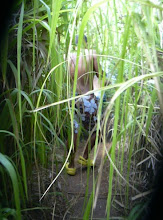Today in class, the work in progress towards the improvement and perfection of the bottom game involved the fluttery, buttery, rolling and flowing butterfly guard. Normally this type of guard is somewhat of a less secure guard in comparison to something like full guard so staying tight is what I always go for with the butterfly. But today, we worked on some things that involved maybe being a bit looser with butterly, say when there is space created by one of the parties when the butterfly flies into position.
Butterfly Guard positions of the day-(A=bottom man, B=top man)
1) A has a seated butterfly position instead of being flattened on his back. Unable to flatten out A to limit his offense and begin to attack, B perhaps pulls away or creates space to prevent A from securing grips/underhooks. A reaches into B's collar for a cross collar grip with four fingers in and entering at the same level of B's chin. THe grip does not have to be super deep or else it may impede or break your the grip when trying to complete the submission. As A pulls himself up, he simultaneously sits up while aligning the inner forearm blade with B's throat and placing his own face next to B's head. A & B should now be touching about cheek to cheek. A should already have his free hand ready as he will palm the back of B's head and push it down so B's face is towards to the ground. As this happens, the shoulder of the arm of A's that is inserted into the collar grip goes over the back of B's head and secures this so B cannot posture back up. A will now roll under B in the direction of the elbow of the collar gripping arm. A will continue the roll until underneath B and grab onto B's near tricep/arm and use the necessary force to assist in finishing the choke. The rolling action itself will make the choke very tight. If B rolls onto his own back to relieve the choke, A should roll on top and finish.
2) This position here continues off of the previous one. Placing your own head next to B's was critical to success. But now, B's arm/shoulder was in the way and A was unable to place his head next to B's so the choke is not as tight anymore. However, A can persist with the choke and still roll and try to finish staying tight. As B walks with direction A is trying roll and finish, this helps relieve the choke. A must fight to stay in a 69 position and prevent B to become perpendicular to him (this causes a pass). A throws his legs backwards overhead and drives his hips up coming out from under B and landing on B's back with the hooks.
3) Here, the the previous two positions are negated because B now holds A's pant with a solid grip and stiffens his arms to keep A's legs to the ground. Keeping a cross collar grip, A uses the free hand to overhook B right on the elbow joint and pulls it tight to himself. This may cause pain to B as it extends his elbow but submitting with this is not the point here as it is low percentage. THe same side of the overhook will see A place his foot on B's hip. A releases the cross collar grip and secures a deep underhook and grabs the belt if possible. THis side will have the butterfly hook inserted right behind B's knee. With the overhooked arm+foot on hip and underhook+butterfly hook, A rolls onto his own back then pushes with the foot on hip and extending the butterfly hook rolling on to side if the overhooked elbow/arm. A lands in mount with foot possibly trapped. If A's butterfly hook is too deep, the leg may get caught and B may land in a Jeff Glover deep half guard.
This stuff is cool and worth reviewing as the options to attack present itself when the top man wants to create space for standing passes and escape tight underhooks.
